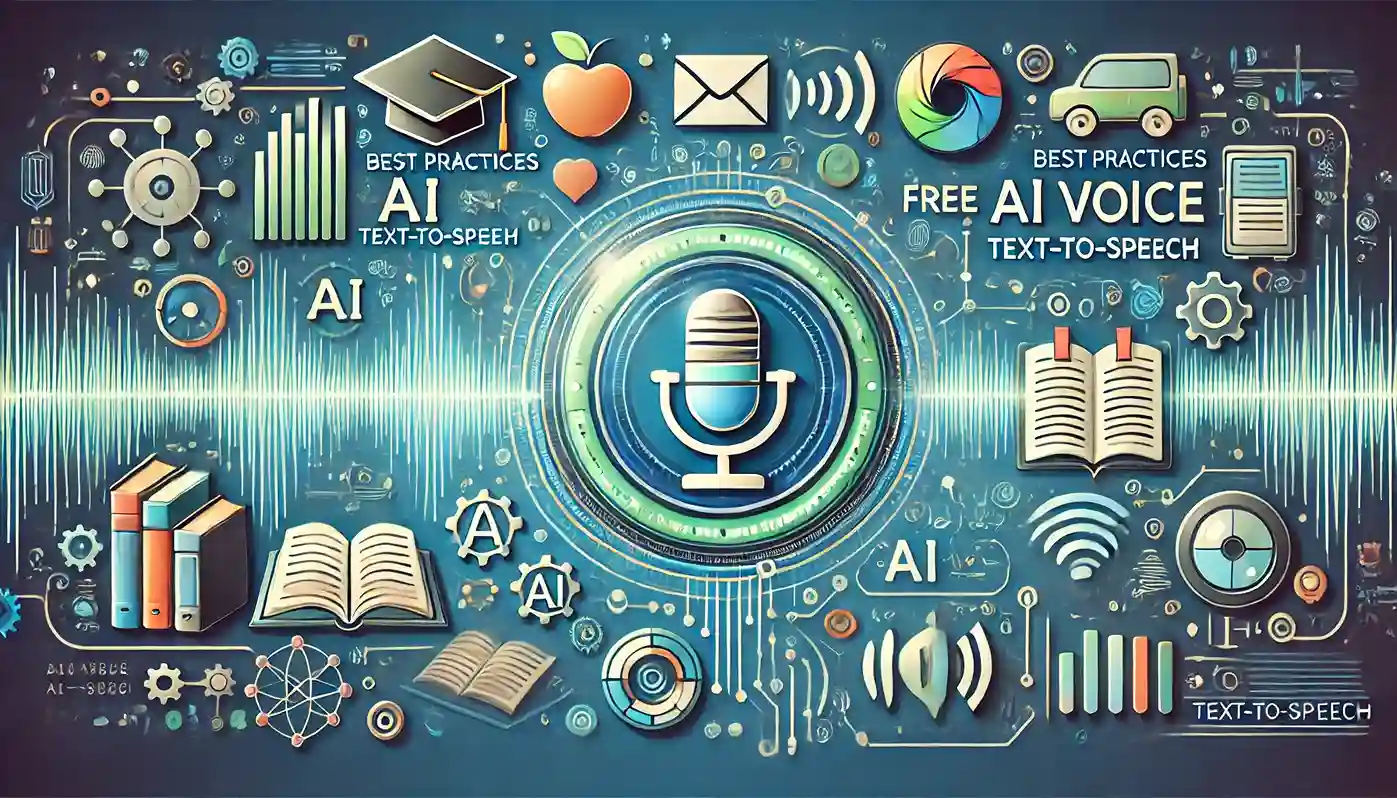
Text-to-speech (TTS) technology has revolutionized the way educational content is created and consumed. With advancements in artificial intelligence (AI), free AI voice TTS tools have become increasingly sophisticated, offering realistic and natural-sounding voices that enhance learning experiences. These tools are invaluable for educators, content creators, and students alike, providing accessibility, engagement, and convenience.
However, to maximize the benefits of free AI voice TTS tools in educational content, it is essential to follow best practices. This blog explores key strategies for effectively using these tools in educational settings.
- Choosing the Right AI Voice for Your Audience
The success of educational content often hinges on its ability to connect with the audience. When selecting a free AI voice TTS (text-to-speech) tool, it’s crucial to consider the demographics and preferences of your learners. Younger audiences may respond better to upbeat and enthusiastic voices, while adult learners might prefer a more formal and authoritative tone. Many free ai voice text to speech tools offer a variety of voices, including different accents, genders, and age ranges. Experiment with different options to find the voice that best matches the tone and style of your content.
Tip: Use the same voice consistently throughout your educational material to create a cohesive learning experience.
- Ensuring Content Clarity and Simplicity
One of the most important aspects of using TTS in educational content is ensuring that the text is clear and straightforward. AI voices, while advanced, still rely on the quality of the input text. Complex sentence structures, jargon, and ambiguous phrases can lead to mispronunciations or confusion for the listener. When creating content for TTS, aim for simplicity and clarity. Break down complex concepts into manageable parts, use short sentences, and avoid unnecessary technical language unless it’s essential to the topic. Additionally, using free AI voice text-to-speech tools can help creators test and refine their content to ensure optimal clarity and accessibility for the audience.
Tip: Before finalizing your content, run it through the TTS tool to ensure that it sounds natural and easy to understand.
- Optimizing the Speed and Pacing of the TTS Output
Pacing is a critical factor in the effectiveness of TTS in educational content. If the speech rate is too fast, learners may struggle to keep up; if too slow, they may lose interest. Most free AI voice TTS tools allow you to adjust the speed of the narration. For educational purposes, it’s important to strike a balance that maintains engagement while ensuring comprehension.
Tip: Consider the difficulty level of your content when adjusting speed. For complex topics, a slower pace may be beneficial, while simpler material can be delivered more quickly.
- Incorporating Interactive Elements
AI voice TTS can be an engaging tool, but to fully captivate your audience, consider integrating interactive elements into your educational content. Quizzes, polls, and prompts for reflection can be narrated by the AI voice, encouraging active participation from learners. By making the learning process more dynamic, you increase the likelihood of retention and understanding.
Tip: After a key concept is explained, have the AI voice ask a question or provide a summary to reinforce learning.
- Enhancing Accessibility
One of the greatest benefits of AI voice TTS tools is their ability to make educational content more accessible. For students with visual impairments, reading difficulties, or learning disabilities, TTS provides an alternative way to engage with material. However, to maximize accessibility, it’s important to ensure that the AI voice accurately conveys the content, including nuances and important details.
Tip: Pair TTS with visual aids like slides or diagrams to support different learning styles and needs.
- Customizing the TTS Experience
Many free AI voice TTS tools offer customization features that allow you to fine-tune the output to better suit your educational content. This can include adjusting the pitch, adding pauses, or emphasizing certain words. Customization can make the narration more engaging and ensure that critical points are highlighted effectively.
Tip: Use pauses strategically to give learners time to process information, especially after complex explanations.
- Maintaining Consistency in Voice and Style
Consistency is key when using TTS tools across multiple pieces of educational content. Changing voices or tones midway can disrupt the flow and distract learners. Once you’ve selected a voice that fits your content, stick with it throughout the lesson or course. Consistency in style and pacing also helps build familiarity and trust with your audience, making the learning process smoother.
Tip: If you’re creating a series of lessons, maintain the same AI voice and pacing across all sessions for continuity.
- Testing and Refining Content
Before releasing your educational content, it’s important to test it with a sample audience. This could be a small group of students, colleagues, or peers. Gather feedback on the clarity, pacing, and overall effectiveness of the AI voice narration. Use this feedback to refine your content, making adjustments to the text, speed, or voice as needed.
Tip: Regularly update your content based on feedback and advancements in TTS technology to keep it fresh and effective.
- Balancing AI Voice with Human Interaction
While AI voice TTS tools are powerful, they shouldn’t completely replace human interaction in educational settings. Blending AI narration with live discussions, Q&A sessions, or teacher-led explanations can provide a richer learning experience. Use AI TTS for delivering content, but complement it with opportunities for learners to engage directly with educators or peers.
Tip: Schedule live sessions after TTS-based lessons to allow students to ask questions and deepen their understanding.
- Adhering to Ethical Considerations
As with any AI technology, ethical considerations are important when using TTS tools in education. Ensure that the content narrated by AI aligns with educational standards and is culturally sensitive. Additionally, be transparent with students about the use of AI in your content, explaining how it enhances their learning experience.
Tip: Avoid over-reliance on AI by ensuring that human oversight is always part of the content creation and delivery process.
- Leveraging TTS for Multilingual Education
Free AI voice TTS tools can also be used to create multilingual educational content. For learners who speak different languages, TTS can provide translations or explanations in their native tongue, enhancing comprehension. Many TTS tools support multiple languages and accents, making it easier to cater to a diverse audience.
Tip: When creating multilingual content, ensure that translations are accurate and culturally appropriate.
- Monitoring and Analyzing Learner Engagement
To continuously improve the effectiveness of TTS in educational content, it’s important to monitor learner engagement. Use analytics tools to track how students interact with the content, paying attention to completion rates, time spent on tasks, and quiz results. Analyzing this data can help you identify areas where the TTS tool is particularly effective or where adjustments are needed.
Tip: Regularly update your content based on insights from engagement data to keep it relevant and impactful.
- Exploring Advanced Features and Integrations
As AI voice TTS tools evolve, new features and integrations are becoming available. Some tools now offer capabilities such as emotion detection, personalized voice synthesis, and integration with learning management systems (LMS). Exploring these advanced features in the best AI apps can further enhance the learning experience and provide more personalized educational content.
Tip: Stay informed about the latest developments in TTS technology and consider integrating them into your educational strategy.
Conclusion
Free AI voice text-to-speech tools are transforming the way educational content is created and delivered. By following these best practices, educators and content creators can ensure that their materials are engaging, accessible, and effective. Whether you’re using TTS to support students with disabilities, create multilingual resources, or enhance traditional teaching methods, the potential of this technology is vast. As you experiment with and refine your use of AI voice TTS tools, you’ll discover new ways to enrich the learning experience and make education more inclusive and engaging for all.
Read more on WCCO






